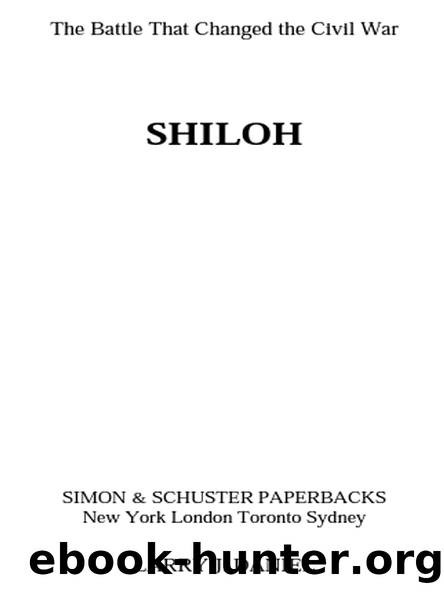SHILOH by LARRY J. DANIEL

Author:LARRY J. DANIEL
Language: eng
Format: epub
Publisher: POCKET BOOKS
Published: 2003-07-15T00:00:00+00:00
NINE Lost Opportunity?
Tilghman Branch
THE DEEP, BROAD RAVINE of Tilghman Branch ran parallel to the Tennes see River and extended from Snake Creek to the Western Corinth Road, where it broke into a number of smaller ravines. Although Sherman’s and McClernand’s divisions managed to keep the Rebels west of the branch, the bluecoats withdrew to defend the Hamburg-Savannah Road and the Snake Creek bridge, thus securing the approach route for Lew Wallace’s belated division. Buckland’s brigade, the only intact unit remaining with Sherman, came into line along the northern portion of the James Perry Field. Although the fences along the road had been torn down, blackberry and sassafras bushes still marked the border of the open field (a cotton field, Sherman later recalled) in their front. 1
Sherman had dispatched Captain J. H. Hammond to the landing to summon additional artillery. About 3:30, the six guns of Captain Edward Bouton’s Battery I, 1st Illinois Light Artillery, rumbled into northern Perry Field. Arriving with the Chicago gunners were 250 men of the 53rd Ohio, about all that remained of Hildebrand’s brigade, which was placed in support of the battery. At 5:00, two of Hickenlooper’s guns, fresh from their stand in the Sunken Road, unlimbered in Mulberry Field. 2
Between Perry and Mulberry Fields was a densely wooded ravine that extended two hundred yards. Sherman feared that it might be occupied by enemy snipers in an effort to drive off the artillerymen. He ordered one of his colonels to occupy the area, but the officer failed to grasp the tactic. Colonel Thomas Sweeny, who had gone to the rear to have his wound dressed, happened to be standing nearby and volunteered “Sweeny, go at once and occupy that ravine, converting it into a regular bastion,” Sherman ordered. 3
About 4:00, Bouton’s battery was shelled from the south end of Perry Field across Tilghman Branch. A lengthy and brutal exchange erupted with Ketchum’s Alabama Battery, later reinforced with the Washington Artillery, which the Chicago press labeled the “Great Artillery Duel.” Although having one gun and a number of horses disabled, Bouton maintained his position until 5:00. 4
McClernand’s brigades withdrew east through Cavalry Field, camp of the 4th Illinois Cavalry, toward the Purdy-Hamburg Road. Along a ridge between the field and the road, a new line was formed facing west, thus creating an obtuse angle with Sherman’s division. McClernand’s right probably stretched to the Hamburg-Savannah Road, giving him interlocking fire with Sherman’s troops. His command was made up of regiments of his own intermingled with two other divisions. Northeast of a lane that is today known as Cavalry Road, and in front of the 15th Illinois camp, two of Veach’s regiments (14th Illinois and 25th Indiana) and one of Raith’s (29th Illinois) came into line about 4:00. Straddling the lane was the 52nd Illinois of Sweeny’s brigade. Southeast of the road were the disordered fragments of six regiments (three each from Colonel Carroll Marsh’s and Raith’s brigades), behind which were posted McAllister’s three remaining guns. Supporting the cannoneers was the 18th Illinois of Colonel Abraham Hare’s brigade.
Download
This site does not store any files on its server. We only index and link to content provided by other sites. Please contact the content providers to delete copyright contents if any and email us, we'll remove relevant links or contents immediately.
| Africa | Americas |
| Arctic & Antarctica | Asia |
| Australia & Oceania | Europe |
| Middle East | Russia |
| United States | World |
| Ancient Civilizations | Military |
| Historical Study & Educational Resources |
1861 by Adam Goodheart(1023)
Smithsonian Civil War by Smithsonian Institution(971)
Abraham Lincoln: A Life, Volume 2 by Michael Burlingame(941)
The Fiery Trial by Eric Foner(915)
Ulysses S. Grant by Michael Korda(901)
Battle Cry of Freedom by James M. McPherson(898)
Rebel Yell: The Violence, Passion, and Redemption of Stonewall Jackson by S. C. Gwynne(894)
Rock of Chickamauga(882)
Abraham Lincoln in the Kitchen by Rae Katherine Eighmey(837)
This Republic of Suffering: Death and the American Civil War by Drew Gilpin Faust(823)
Bloody Engagements by John R. Kelso(798)
Lincoln's Lieutenants by Stephen W. Sears(777)
Union by Colin Woodard(771)
Leaves of Grass by Walt Whitman(767)
The escape and suicide of John Wilkes Booth : or, The first true account of Lincoln's assassination, containing a complete confession by Booth(750)
1861: The Civil War Awakening by Adam Goodheart(721)
Rise to Greatness by David Von Drehle(705)
The Fiery Trial: Abraham Lincoln and American Slavery by Eric Foner(704)
Leaves of Grass (Barnes & Noble Classics Series) by Walt Whitman(666)
